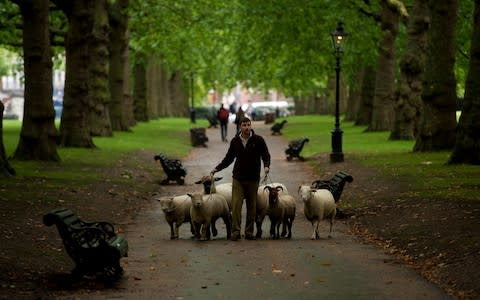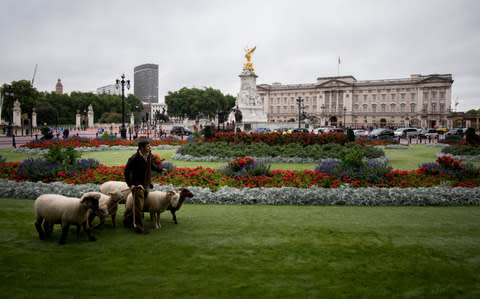'Commuter' sheep grazing in Green Park to help wildlife prove a spectacle for Londoners and tourists

Engaging a shepherd on the various merits of rare breed sheep was the last thing civil servant Wayne Blair expected to be doing on his lunch break in London’s Green Park.
But for Mr Blair, the sight of sheep grazing in the heart of the city was enough to warrant a few questions, not to mention the obligatory mobile phone snap.
“It’s a fascinating thing to see,” he said. “It’s hardly the norm in London. I’m intrigued.”
In fact, as shepherd Tom Davis revealed, grazing sheep could soon become a common sight in the Royal Parks if a trial project to revive Britain’s wildflower meadows, backed by the Prince of Wales, is successful.
“Sheep are kinder to the land than a tractor or mower,” Mr Davis said, as he prodded his crook in a bale of straw.
“They will graze on the tougher vegetation and at the same time, push seeds into the ground to promote germination for next year.”

As Mr Davis patiently explained to the curious throngs taking pictures, he has taken up residence in Green Park for a week with six sheep comprising four rare breeds - the Oxford Downs, Southdowns, Whitefaced Woodlands and a Manx Loaghtan.
The sheep, he admitted, were “commuter sheep” and will only be in the park from 9am until 5pm, when they will be driven back to their usual home - Mudchute Farm in east London’s Docklands.
“They work usual office hours, commuting in the London traffic,” Mr Davies smiled.
It was all a far cry from the 1930s, when sheep last grazed in the Royal Parks.
The sheep were herded into a fenced enclosure encompassing two thirds of one of the park's two wildflower meadows, yesterday (MON) morning, prompting surprised glances from policemen outside Buckingham Palace.
The rare breeds have been selected because, unlike modern commercial breeds, they can survive on the natural vegetation alone and do not rely on supplementary feed.
It is hoped this natural conservation method will tame the dominant plants, allowing flowers to flourish and a rich diversity of invertebrates to grow.
The initiative is part of the Royal Park’s year-long Mission Invertebrate project, which has received £600,000 from the People’s Postcode Lottery.
For the tourists strolling to or from Buckingham Palace and the Londoners enjoying a brief escape from the office, the sheep were a welcome sight.
Mr Davis, with his tractor and crook, not to mention Mavis, his Patterdale terrier (“I couldn’t afford the stereotypical black and white collie), proved equally fascinating.
Against the background hum of the Piccadilly traffic, he revealed that some of those who had approached him for a chat had never seen a sheep before.
“A lot of people think a sheep is a sheep but you couldn’t get further from the truth,” he said.
“We have 68 breeds of sheep indigenous to the UK, more than any other country, and each is bred to fit an agricultural niche.
“This project is one hell of a thing really. I’m glad we have been able to be a part of it.
“Without the bugs and the beasties, you don’t have the foundation for anything else.”
It will be several months before it is known if the trial was a success, when experts will compare the numbers of invertebrates and plants in the meadow with the part left ungrazed.

A monthly invertebrate survey will also provide updates on progress.
If deemed worthwhile, shepherds and their sheep could become a regular sight once again, with provisional plans in place to introduce flocks to Hyde Park, Regent’s Park and Richmond Park.
The Prince of Wales is a huge advocate of the project, recently urging every farmer in the country to plant at least one wildflower meadow on which cattle or sheep can live.
He even helped Mr Davis plant Green Park’s second wildflower meadow in the shadow of the Bomber Command Memorial last year.
“He’s a farmer himself, he’s very knowledgable and gets stuck in “ Mr Davis said.
Asked if he was expecting a royal visit this week, Mr Davis gave a wry smile.
“Well, I don’t know, I think he’s away at the moment,” he said. “What would I know, I’m just a humble shepherd.”

 Yahoo News
Yahoo News 
